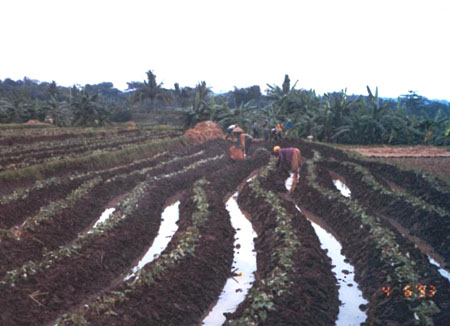Drought stress
Sweetpotato is known as a relatively drought-tolerant crop. It is most
commonly grown under rainfed conditions, or with irrigation during seasons where
availability of irrigation water may be insufficient for other crops.
Nevertheless, crop performance is maximized when the soil is maintained
constantly moist: below field capacity (wet but fully drained) and above wilting
point.
Sweetpotato requires a period of moist conditions after planting, until the
root system is well developed. Thereafter, it will tolerate brief periods of
drought stress, recovering quickly when soil moisture is restored. However,
prolonged dry conditions will restrict root development as well as limiting the
photosynthetic ability, producing a stunted, hungry-looking crop. Storage root
development may be impeded, leading to shorter or misshapen roots.
High soil temperature, which often accompanies dry conditions, can lead to
further damage of fibrous root and storage root development. Conversely,
catastrophic failures of sweetpotato crops during drought in highland Papua New
Guinea have been largely attributable to frosts, brought about by the clear
skies and low humidity.
Maintaining soil organic matter is probably the most important management
practice for managing water supply in rainfed crops. Organic matter incorporated
through the soil will help it to hold more water and remain moist for longer.
Plant mulches applied to the surface of the soil also help to reduce surface
evaporation and keep the soil temperature even. They also prevent soil crusting
and improve infiltration when rain arrives. Weeding is also important, as weeds
compete with the crop for water and accelerate soil drying. Uprooted weeds can
be left on the soil as mulch.
Where irrigation is available, a number of factors should be considered in
irrigation management:
- The aim is to keep the soil moisture conditions as constant as possible.
In general, more frequent, light irrigations are preferred to larger
applications less frequently.
- Sufficient water should be applied to wet the root zone, without causing
deep drainage or run-off. Apart from being wasteful of water, overwatering
can cause considerable loss of soil nutrients (leaching) while
contaminating the groundwater and streams with the nutrients, which may be
directly toxic to people or promote algal growth and eutrofication.
- Light-textured (sandy) soils will require more frequent irrigation than soils
with high clay or organic matter content. Light-textured soils will also
require less water to wet them through, and are more prone to leaching and
run-off losses.
- The crop’s water needs will be much higher in clear, hot and/or windy weather
than in still, overcast weather.
Waterlogging
Sweetpotato is much less tolerant of excess water than of drought.
Waterlogging eliminates air from the gaps in the soil. Sweetpotato roots are
very sensitive to lack of oxygen, and are damaged by even brief periods of
waterlogging. If the soil is insufficiently drained, the active root system will
be restricted to the soil very near the surface, making plants more vulnerable
to drought stress as soon as conditions become dry. The limited volume of soil
available to the plant will also exacerbate nutrient stresses leading to
stunting and yellowing of foliage. Storage roots will not develop in the
waterlogged zone, and even brief periods of waterlogging at the time of storage
root initiation can greatly reduce yield.
Sweetpotato is usually grown on ridges or mounds in order to promote rapid
drainage of the root zone and avoid waterlogging damage. In very wet conditions,
or with heavy soil, higher ridges may be needed than in drier conditions or with
light-textured soil.
Soil organic matter helps to maintain an open soil texture, which speeds
drainage, while also maximizing the amount of water that is retained in the soil
for crop use.
References
Basic understanding of horticulture. http://www.fao.org/docrep/X5642E/x5642e06.htm.
20 November, 2002.
Saupe, S. G. Plant
Physiology.
http://employees.csbsju.edu/SSAUPE/biol327/lecture-home.htm
St. John's University; Biology Department; Collegeville, MN. 21
November, 2002.
van
de Fliert, E. and Braun, A. 1999. Farmer field school for integrated crop
management of sweetpotato. Field guides and technical
manual. International Potato Center. Lima, Peru. 266 p.
Contributed
by:
Jane O'Sullivan |
Other
topics under Crop Management:
Land
preparation
Production
of planting materials
Planting
Soil
management
Vine
lifting
Integrated
pest management
Harvesting
Postharvest
practices

Contour furrow irrigation of a sweetpotato field in Indonesia
 Hand
watering a field in the Philippines |

